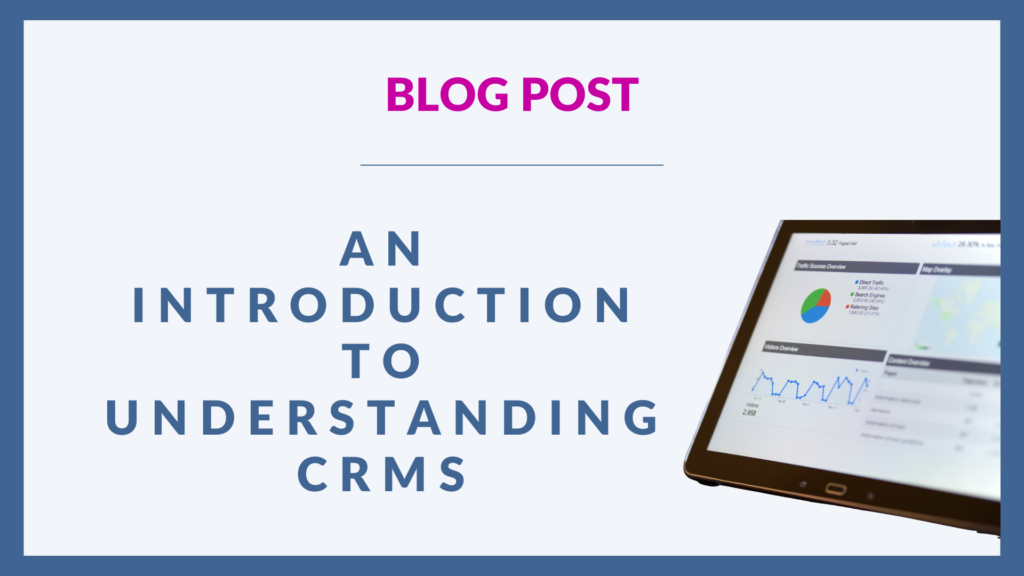An Introduction to Understanding CRMs

October 23, 2024 Emma Shergold AN INTRODUCTION TO UNDERSTANDING CRMs Customer Relationship Management, or CRM, has become essential software for modern businesses. Whether you’re a start-up or an established company, a CRM system can transform how you store your data, interact with your clients or customers, manage sales, and grow your business. This blog will summarise what is meant by a CRM, what they are used for, and how to choose the best one for you and your business. Throughout the blog I have linked several different software, but there are currently no affiliated links on this blog. WHAT IS A CRM Although CRM stands for Customer Relationship Management, I prefer to refer to it as a Contact Relationship Manager because, quite frankly, that covers data that is collected for everyone involved in a business, not just customers. However, the main function is designed to help businesses manage and analyse interactions and data throughout the lifecycle of each contact. A CRM centralises all your contact data in one accessible place. This includes contact information, communication history, sales, potential sales, and notes. It is effectively a digital filing cabinet that everyone in the business can access and update rather than everything being in one person’s email software or phone. And, unlike a traditional filing cabinet, people can’t (easily) remove , records, leaving you searching the office for it! THE CORE FUNCTIONS OF A CRM Most CRMs share several key functions. Contact management allows you to store and organise comprehensive profiles with all relevant details in one place. Sales pipeline management helps you record and track potential clients/customers as they progress from the initial lead to securing the contract, showing what is being worked on and providing estimated income projections. Communication tracking records every interaction, such as emails, calls, and meetings so that anyone looking at the CRM can see who has recently been contacted and any outcomes or follow ups that need to be actioned. Task and activity management helps you to keep track of what needs doing with a contact or project. Many projects require the input of contractors or suppliers, so this is where storing other contacts aside customers/clients can be beneficial. WHY BUSINESSES USE CRMs The main reasons come down to practicality and efficiency. CRMs help to reduce the time it takes to track down a contact’s details and associated notes or tasks by giving everyone in your business access to the information. Your sales team isn’t duplicating work because everyone can see what’s already been done. Customer service is improved because support agents understand the contact’s full history with your company. Even if you are a sole trader, a CRM can help you keep all your contact data, notes and tasks in one place, which reduces the time it takes to find the right notebook or search through emails and texts for the information you need. Overall, efficiency increases substantially, and this is key to a successful (and profitable) business. Most CRMs have automation features* like automated email sequences, task reminders, and workflow triggers, which help reduce the manual admin side of things. Perhaps most importantly, CRMs can improve your revenue. By understanding your customers better, you can identify upsell and cross-sell opportunities. You can segment customers to target marketing efforts more effectively. You can identify which customers are at risk of leaving and take action to retain them. *This is usually within paid versions of CRM software, although there are often workarounds and third party automations that can be used. CHOOSING THE RIGHT CRM FOR YOUR NEEDS Here’s an important truth: not every business needs a full CRM platform. The right solution depends entirely on what you’re trying to achieve and what other tools you’re already using. Below are the main options available: Simple Contact Storage: The Spreadsheet Approach If your primary need is simply to store contacts so that everyone in your business has access to the same information, a well-organised spreadsheet might be all you need. A shared spreadsheet in Google Sheets or Excel provides a centralised location where you and your team can view and update contact details. This approach has real advantages: it’s free, requires no training, and you have complete control over your data structure. More importantly, building a spreadsheet first is an excellent way to understand what data your business actually needs to collect. It forces you to think about which fields matter. Names, email addresses, phone numbers, company information, and sales history are the basic data categories, but there are so many others provided by a CRM platform that you won’t need. This foundational work is invaluable. If/when you move to a CRM platform, you’ll have clean, organised data and a clear understanding of your requirements. A well-maintained spreadsheet can also serve as reliable data ready for upload into whatever CRM platform you choose later. Download your FREE CRM Spreadsheet Template Building Relationships and Managing Tasks: Time for a CRM platform If you want to move beyond simple contact storage and focus more on build relationships, tracking interactions, creating follow-up tasks, managing a sales pipeline, or coordinating team efforts, then a dedicated CRM platform becomes a lot more valuable. Although the CRM Spreadsheet Template will help you to manage relationships and use functions like Conditional Formatting to highlight follow-ups, a CRM platform allows you to easily integrate with your other software and systems to create and allocate tasks linked to contacts, opportunities and (sometimes) projects/events. When choosing a CRM platform, consider what other software your business relies on. Does it need to integrate with Outlook or Gmail? Would you like it to work seamlessly with your email system? Integration capabilities are crucial because you (and your team) will actually use the platform if it fits naturally into their existing workflow. A CRM that requires switching between multiple windows will often meet with user resistance. Email and Contact Management: Mailing Software as an Alternative There is another option worth considering, especially if email communication is a priority. Mailing software
